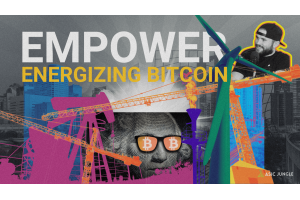Throughout the history of oil production, stranded natural gas has been a problem without a suitable solution. When oil is drilled, natural gas is produced as a byproduct. The decomposition of landfills produces waste streams of methane gas, too. Oftentimes, it isn’t possible or viable for oil producers to harness this natural gas so that it can be used by consumers, and in these cases the natural gas is burned off in a process called flaring.
Bitcoin mining offers new opportunities to put this excess energy to use in a productive way. Bitcoin mining operations are often on the lookout for ways to utilize green and renewable energy sources, counter to the narrative that Bitcoin mining is environmentally irresponsible. Bitcoin mining’s power requirements represent a significant opportunity in terms of developing more efficient, synergistic infrastructure.
Recently, flare mitigation strategies were promoted by the World Economic Forum—representing a step towards the use of otherwise wasted oil industry byproducts to mine Bitcoin sustainably. Let’s take a look at how flaring and waste methane mitigation is being used for Bitcoin mining.
Why does methane gas get flared?
The question of what to do when you hit a natural gas formation when you’re drilling for oil has been a challenge for oil and gas companies since the beginning of oil production in the United States, nearly two hundred years ago.
Oil can be trucked around, but transporting gas requires pipeline infrastructure. Sometimes, drilling sites happen to be within close enough range to pipelines that natural gas can be sent by pipeline to buyers. Far more commonly, however, the only possible solution is burning the natural gas off, which is why you’ll often see flames burning at oil fields.
There are a number of safety, regulatory, and technical reasons why methane gas is flared as part of oil and gas production. Flaring methane is a relatively safe practice, but the greenhouse gas emissions it produces are a downside. Greenhouse gas emissions also come from the burning carbon dioxide, nitrogen oxides, and particulate matter involved.
It’s not ideal to be burning off greenhouse gasses without deriving some utility from them. Methane remains in the atmosphere for a shorter duration than carbon dioxide does, but it is more potent than CO2, trapping many times more heat. It also certainly isn’t optimal from an economic standpoint to be disposing of natural gas rather than selling it. It’s estimated that the hundreds of billions of cubic metres of gas flared off every year could power all of Sub-Saharan Africa.
Bitcoin miners are ahead of the curve on flared energy
In the World Economic Forum’s video about capturing flared gas, they refer to the ability of data centres to divert trapped natural gas, but they don’t mention Bitcoin mining specifically. The WEF’s video focuses on the work of Crusoe Energy Systems: a Denver-based company that has been offering flaring mitigation services largely centred around mining Bitcoin.
It stands to reason why the World Economic Forum would refrain from mentioning Bitcoin specifically—electing instead to use the vague term “data centres”—but it’s disingenuous, as it fails to credit the role Bitcoin plays in this innovative and sustainable practice.
The energy requirements of Bitcoin’s proof of work mechanism have been well-documented by those who want to place prohibitive restrictions on Bitcoin mining. It’s dishonest that success stories related to environmentally-friendly Bitcoin mining are not documented in the same way that challenges are.
What is the flaring diversion process?
Crusoe Energy Systems builds, operates, and manages mobile, modular data centres that they bring on location to flaring sites so that they can utilize the methane gas that would otherwise be wasted. Methane flares happen all over the world, and Crusoe plans to continue to expand so that they can operate globally.
Companies like Crusoe tend to bring shipping containers with extensive mining hardware onto existing oil sites. When natural gas emerges in the drilling process, it’s diverted to generators, which convert the gas into electricity that is used to power the mining hardware. Compared to flaring, this kind of process cuts down on greenhouse gas emissions by around two thirds.
Crusoe is one of the WEF’s “Innovator Communities.” In addition to Bitcoin mining, Crusoe Energy also powers deep learning and AI applications, and other intensive research projects.
Mainstream acceptance of flaring diversion as reusable energy source
In the United States, the work of companies like Crusoe has been picking up steam as being a widely-recognized source of renewable energy.
In 2021, Texas senator Ted Cruz spoke about potential for methane flaring mitigation to be used as a way to mine Bitcoin in an affordable and environmentally friendly fashion, calling it an “enormous opportunity” to make use of energy that “is just being wasted”.
Hybrid energy solutions are growing in adoption
Using stranded natural gas to power mining hardware is the kind of innovative thinking that has become common in the Bitcoin mining landscape. In areas that posess extensive oil and gas infrastructure, Bitcoin mining has aided in the adoption of hybrid energy solutions that make use of power from a range of sources, depending on availability and demand.
Recently, Texas has emerged as a world leader in Bitcoin mining, featuring several of the largest mining facilities anywhere in the world in terms of power capacities. Texas is an interesting case when it comes to power requirements. During certain periods, renewable energy (particularly wind and solar in West Texas) is overabundant, and mining operations are able to use cheap renewable energy that would otherwise go to waste.
Though Texas is home to some of the biggest Bitcoin mines in the country and some of the most forward-thinking energy solutions, Bitcoin mining remains a controversial topic in the state. Events like the 2021 Texas Power Crisis have highlighted the fact that the state’s grid is outdated and fragile to some degree, which causes some people to worry about industries that consume substantial electricity in the state.
At times when Texas’ independent energy grid is overburdened, Bitcoin miners tend to have agreements with the grid wherein they scale back usage so that sufficient power will be available to residential customers. Bitcoin mining companies are particularly well-suited to this kind of arrangement, as power consumption can be stopped and started much more nimbly than most other institutional consumers of significant energy.
The future of environmentally-friendly Bitcoin mining
One of the key factors that drives a lot of newcomers towards the Bitcoin mining landscape is that it’s a site of explosive growth, home to innovative thinking about natural resources and power. Bitcoin mining enterprises across the United States and the world are providing jobs in rural communities, stabilizing demand for renewable energy, and making use of underutilized infrastructure and resources.
As we’ve seen with this example of otherwise stranded energy powering Bitcoin’s proof of work mechanism, there are huge opportunities out there for Bitcoin to be mined in a responsible fashion, making use of energy sources that had otherwise been going to waste. Bitcoin mining is one of the fastest growing industries, and Bitcoin mining has the ability to transform the economics of the energy industry.
In addition to forward-thinking energy solutions, the future of Bitcoin mining is also rooted in mining initiatives having access to the latest mining hardware at the best possible prices. Asic Jungle has emerged as a leader in the Bitcoin mining hardware procurement space, offering customizable solutions to suit mining enterprises of any size, from small, new projects to large, institutional players. Get in touch to get on board with the best experience in acquiring ASICs.






